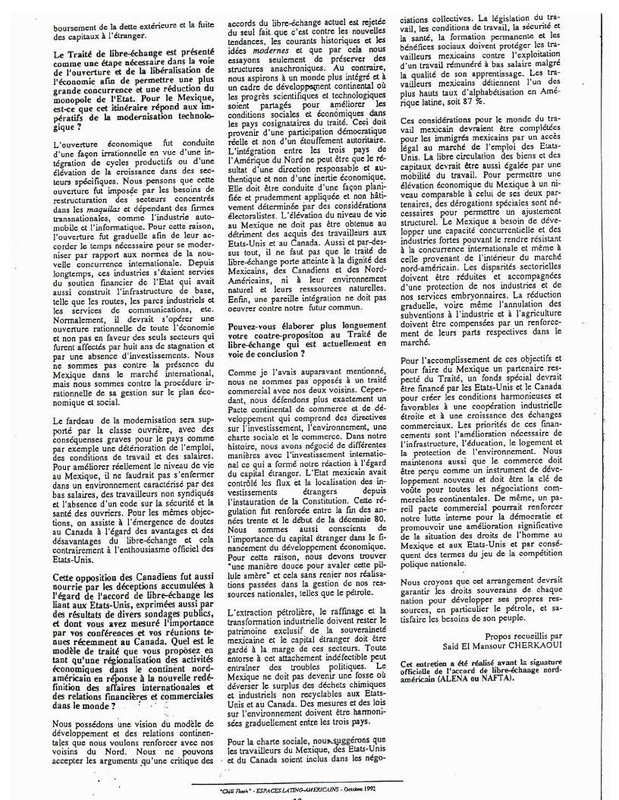Dr. Said El Mansour Cherkaoui has conducted research on Brazil, Mexico, Latin America since 1979 at the Institut de Recherches Economiques et de Planification, Université de Grenoble, France. In 1981, Said El Mansour Cherkaoui spent one year conducting research at the University of California Berkeley, at the Center for Latin American Studies – CLAS at Berkeley and Simon Bolivar House at the Stanford University. The following year, Said El Mansour Cherkaoui joined the Institute des Hautes Etudes sur l’Amérique Latine, Université de la Sorbonne and the Centre de Recherche et de Documentation sur l’Amérique Latine, CREDAL in Paris where he published one of his research on the Economic Intervention of the Brazilian State.

Author: Said El Mansour Cherkaoui holds a Doctorate on Economics from the Université de la Sorbonne and the Institut des Hautes Etudes de l’Amérique Latine, Paris. Dr. Cherkaoui conducted Research and is a Published Author at the Centre de Recherche et de Documentation sur l’Amérique Latine, Laboratoire 111 Associated with the Centre National de la … Continue reading Said El Mansour Cherkaoui on Latin America – MOROCCO DIGITALL AFRICA
Said El Mansour Cherkaoui Research – Publication: From NAFTA to CUSMA

Said El Mansour Cherkaoui From NAFTA to CUSMA December 8, 1987 – December 8, 2021:From #NAFTA to #CUSMA Lic Cuautémoc Cárdenas – Cuauhtémoc Cárdenas Solórzano David Fike – President of Golden Gate University Publications of Said El Mansour Cherkaoui on Mexico and the Integration of North American MarketThe North American Free Trade Agreement (NAFTA) was signed into law by the U.S….Read More
Said El Mansour Cherkaoui and Brazil

Said El Mansour Cherkaoui – ECONOMIE POLITIQUE DU SUBCAPITALISME EN AMERIQUE LATINE (1830-1930) : ARGENTINE – BRESIL – CHILI – PEROU. سعيد المنصور شرقاوي saidcherkaoui24@gmail.com Version Française: Dr. Said El Mansour Cherkaoui est diplômé de l’Institut des Hautes Etudes de l’Amérique Latine et de l’Université de Sorbonne, de l’Institut de Recherche Économique et de Planification et de l’Institut de Sciences…Read More
Re-Globalization of the U.S. Trade and Reviving Mexico Supply Chain
Mexico became the top U.S. trading partner at the beginning of 2023, with total bilateral trade between the two countries totaling $263 billion during the first four months of this year.
Mexico’s emergence followed fractious U.S. relations with China, which had moved past Canada to claim the top trading spot in 2014. The dynamic changed in 2018 when the U.S. imposed tariffs on China’s goods and with subsequent pandemic-era supply-chain disruptions that altered international trade and investment flows worldwide.
Mexico’s gains mirror its rise in manufacturing, a key component of goods moving between it and the U.S. During the first four months of 2023, total trade of manufactured goods between Mexico and the U.S. reached $234.2 billion.
Overall, Mexican imports to the U.S. totaled $157 billion; U.S. exports to Mexico reached $107 billion.
Mexico–U.S. trade during the first four months of 2023 represented 15.4 percent of all the goods exported and imported by the U.S.; the Canada–U.S. share followed at 15.2 percent and then the China–U.S. share at 12.0 percent (Chart 1).

After nearly a decade, China is no longer the United States’ top trading partner. That position now goes to Mexico, with Canada right behind it. China’s getting bumped from the top two spots can be traced to the Trump administration’s 2018 import tariffs, which remain in place today; pandemic supply chain problems also played a role. In addition to reflecting an increasingly troubled Sino-American relationship, the Mexico-China swap points to “a real shift in the dynamics of the global economy — away from prioritizing low prices and greater efficiency,” writes Axios.
- Reduced trade with China could mean higher costs for U.S. consumers.
Mexico positioned as a manufacturing base
Mexico’s expanding manufacturing base has offered an alternative to producing in China. Sourcing or producing goods in a nearby country is sometimes referred to as “nearshoring.” While data on recent nearshoring is thin and evidence of it is largely anecdotal, increased protectionism and related industrial policy are consistent with less global trade, more regional trade, and nearshoring and reshoring (returning production to the home country).
More activity in Mexico would support increased bilateral manufacturing with the U.S. It would also bolster Mexico’s standing as the U.S.’ leading manufacturing trading partner, a ranking it achieved in 2022 (Chart 2).

The U.S. and Mexico are more than neighbors
The Boomerang Effect by the Dragon of the Day: China in Mexico, Central and Latin America
Why Chinese Companies Are Investing Billions in Mexico?
In 2021, Chinese companies were responsible for 30 percent of foreign investment in Nuevo León, second only to the United States at 47 percent.
China is just catching up with the rest of the developed world and has all the right to expand its relations with Latin America like the rest of the globe, no more Monroe Doctrine or the Mercantilism Time for Latin America.
Latin American countries are opting for diverse international trade, economic and financial relationships and seeking also to learn about different cultures than the ones they inherited from the Europeans.
Since the independence movement and since the mid of the early 19th century, Latin American leaders have been seeking the inclusion of Asians in their economies as a way to reinforce their modernization drive and consolidate their urban population. Brazil and Peru have been in the forefront of such opening and acceptance of Japanese and Chinese citizens to the point that during the second war, Brazil became the target of investigations and surveillance of the Japanese community living mainly in the Sao Paulo State.
In fact, Brazil has been and still is the country who has the largest Japanese community living outside of Japan while Peru had a President of Japanese descent.
Within such historical and cultural ties of Latin America, China actually is renewing and renovating the inheritance of shared common memories that were built by previous generations.
You’re right. Eventually or hopefully it will trickle down to Central America which has way more water resources, including Nicaragua’s giant lake and the aquifers of the volcanic areas of Central America. Not to mention the easy access to the Caribbean and Pacific Oceans. Panama now rivals Chile as the most prosperous country in LATAM. The resources is one of the reasons Central America has been so unstable throughout its history. Central America also has been more friendly to the US with no territorial disputes. Central America can also individually address their corruption issues and Costa Rica and Panama are already less corrupt overall than Mexico.
China and Costa Rica
The Presence of China and Diplomatic Works in the Americas Preferential Trade Agreement Costa Rica is China ‘s second largest trading partner in Central America while China is the second largest trading partner of Costa Rica . In recent years, bilateral trade between the two countries has grown rapidly. In June 2007, China and Costa…Read More
Free Trade and Globalization

What is a trade agreement, anyway? Trade tensions between the United States and the European Union are not dissipating. The most recent spat is publicly unfolding over President Biden’s signature climate legislation, the Inflation Reduction Act (IRA). Nowhere was the lack of rapprochement clearer than during French President Emmanuel Macron’s state visit to Washington last November, where he was reported to…Read More
Mexico became the United States’ top trading partner this year, as our relationship with China worsened. The milestone reflects a real shift in the dynamics of the global economy. Where once low prices were the priority … now there are more concerns at the table, including resilient supply chains and national security. Read the story @Axios
The U.S. and Mexico are more than neighbors
This international trade version of a schoolyard shuffle is amusing. It’s like watching two bullies squaring off, with each one threatening to land a punch, but both too afraid of the potential black eye.
Then suddenly, Mexico appears, quite like the quiet kid who brings candy to the playground, saying, “Hey, how about we be friends instead? It’s a win-win.”
The U.S. takes a moment, looks south, and goes, “Ooooooooooh yeah, I forgot about you” – followed by a forehead slap so loud, it could be heard across the border.
But this doesn’t mean we can put China on ‘read’ and ghost them completely. The dance of diplomacy must go on.
Trade dynamics are ever-shifting. The transition from a China-centric to a more Mexico-inclusive trading scenario is as inevitable as the return of the mullet haircut (please, no).
Like any narrative, there’s a history of love and hate, tariffs and trade-offs, manufacturers and, well, more tariffs. It’s reminiscent of a complicated love triangle on a reality TV show, but with the added thrill of economic consequences and political maneuvers.
Still, as we see Mexico rising like a Phoenix, let’s not forget our old pals. After all, the global economy isn’t a monogamous relationship. …
China’s downward slide has begun. COVID kicked it off. The reduction in global trade was the start, then came their insane “zero-COVID” clownery, then the inevitable fallout when they repealed it. Get ready to read more about “tofu dregs” buildings falling down, the real estate crisis already in progress, the collapse of “Belt-and-Road”, and the reallocation of manufacturing to places like Mexico, India, Vietnam, and even America as automation renders labor prices irrelevant.
On top of all of that, China is going to undergo serious brain-drain in the next decade. Smart people do not want to live under a “social credit” system, nor do they want to live in fear of a draft that would absolutely be needed as an attempted Taiwan invasion gets even more quagmired than Russia in Ukraine and PLA grunts croak by the millions.
The real question is, what will happen to the world economy when China fails. It could be the economic equivalent of Russia failing and a bunch of squabbling nuclear breakaway states appear. Both things need to happen, but it must be managed well. Of course, we don’t have any good managers around.…see more
Declining trade with China means rising costs for US consumers and companies, which could result in stubborn inflation. This can’t be effectively addressed by continuously hiking interest rates for the apparent reason: The Fed can’t fix the worsening diplomatic relations between the US and China.
The key takeaway message from your article then is that prioritizing resilience in supply chains and national security over low prices comes at a high cost—that is, high consumer prices. This can’t be fixed by rising interest rates since interest rates can only solve inflation when the cause is excess demand.…
How is it that cartels are so large, but not affecting trade?
The drug cartels focus mostly on one industry but have been expanding their reach into markets like avocados lately. I don’t see them making inroads into consumer goods. o will reduce its dependence on China so we can reduce dependence by proxy.…see more
Federal Reserve Bank of Dallas
Mexico seeks to solidify rank as top U.S. trade partner, push further past China
#Mexico became the top U.S. trading partner at the beginning of 2023, with total bilateral trade between the two countries totaling $263 billion during the first four months of this year. Luis Bernardo Torres Ruiz explores this trade relationship in the latest on Dallas Fed Economics: https://lnkd.in/gMFzpV6p
As far as prices go, it’s not that much more than China when you factor in shipping cost from overseas and tariffs. Trade with Mexico isn’t the reason for high inflation, it’s because the Fed printed 6 trillion dollars during the pandemic.
“If you have an opportunity to live somewhere, why shouldn’t you be able to?” …
It may not actually be a bad thing. Whether people like it or not, the U.S. and Mexico are neighbors and necessary economic partners. When you look at all of the friction points between the U.S. and Mexico, they can all be traced back to economic under-development below the border. This results in crime, drugs, and illegal immigration. The increase in legal trade with Mexico brings more prosperity to them and provides the lower-priced imports that we have long depended on China for. This increases exchange and business cooperation between the two countries, which leads to more reciprocal economic development. This not only means Americans settling in Mexico, but also Mexicans opening businesses and buying real estate in America.
Congratulations Mexico! Well done. China continues to threaten the world and you stepped up.
This has the added benefit of the neighbor to the south having additional buying power and creating jobs in Mexico. Products might cost a bit more, but more money stays regionally and hopefully helps stem the flow of those needing to leave their countries looking for work.…
So, explain the immigration issue if Mexico is so prosperous.
Nice parts of any Mexican city are already getting pricey, unless you are actually making a full time tech salary. Look to Honduras, Guatemala and Panama
If the United States is unable to address the affordable housing crisis, it is possible that this could lead some skilled workers to seek opportunities elsewhere, including places such as Mexico City. This could trigger a number of changes, including certain cities becoming new technology centers.
Becoming the next Silicon Valley and attracting young American tech workers won’t happen just by solving the affordable housing problem. Other factors, such as regulatory and policy environments, infrastructure investments, and talent development, all influence whether a region can become a hotspot for technological innovation. And what makes Silicon Valley a global technology center is the accumulation and development over the years, in addition to economic factors.
It is indeed necessary to take into account various factors to attract and retain young skilled workers. The Government, enterprises and all sectors of society should work together to provide young people with development opportunities, create a good living environment and promote sustainable economic growth and social development.…
I agree the article and your comment are separate topics. After reading thru everyone’s comments, I find it interesting that no one has stopped to see how Americans moving to Mexico is affecting the people of Mexico negatively. The word gentrification comes to my mind. American companies already have manufacturing plants in Mexico, and pay Mexican Citizens very little to work there. Now Americans are starting to move to Mexico while getting paid salaries that many Mexicans can only dream of. Here is an article on this problem:
https://ascjcapstone.com/terms/spring-2023/cabelloc/
The out-of-control housing prices in America are primarily due to the impact of our own consumers and geographical preferences. When skilled workers flock to DC, Austin, Portland, Seattle, or San Francisco to get higher-paying jobs, inflation is the predictable result. Creating artificial price controls is not a sustainable strategy. But, dispersing industry beyond these metropolises creates competition between regions and this benefits consumers.…
Mexico is already the #1 place for expats to live and work remotely. And with the proximity to the US it makes it easy for people to travel back to the States to see family and friends.
There is an article in the LA Times about a bunch of remote American workers moving to Mexico City and pushing rent prices through the roof for the locals. Now they want the Americans out. Guadalajara is already doing that within MX. And it has a ton of expats.
































